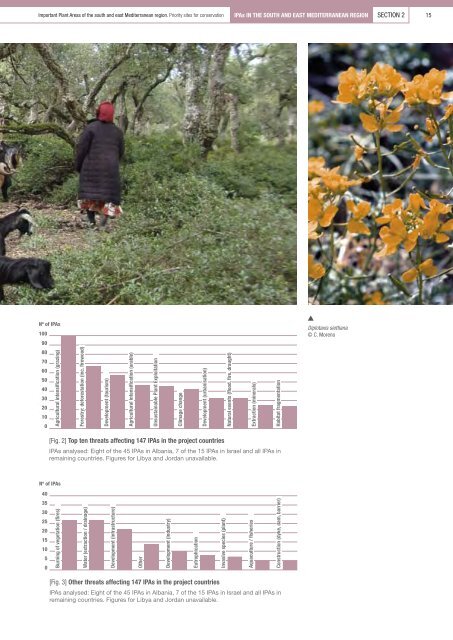Important Plant Areas of the south and east Mediterranean ... - IUCN
Important Plant Areas of the south and east Mediterranean ... - IUCN
Important Plant Areas of the south and east Mediterranean ... - IUCN
Create successful ePaper yourself
Turn your PDF publications into a flip-book with our unique Google optimized e-Paper software.
<strong>Important</strong> <strong>Plant</strong> <strong>Areas</strong> <strong>of</strong> <strong>the</strong> <strong>south</strong> <strong>and</strong> <strong>east</strong> <strong>Mediterranean</strong> region. Priority sites for conservation<br />
IPAs in <strong>the</strong> <strong>south</strong> <strong>and</strong> <strong>east</strong> <strong>Mediterranean</strong> region<br />
SECTION 2<br />
15<br />
Nº <strong>of</strong> IPAs<br />
The importance <strong>of</strong> <strong>the</strong> threat <strong>of</strong> overgrazing contrasts with <strong>the</strong> analysis<br />
100<br />
<strong>of</strong> threats to ‘key biodiversity areas’ in <strong>the</strong> <strong>Mediterranean</strong>, that have been<br />
90<br />
identified largely using o<strong>the</strong>r taxa (birds, fish, reptiles <strong>and</strong> amphibians). The<br />
80<br />
primary threat to <strong>the</strong>se key biodiversity areas was identified as infrastructure<br />
70<br />
<strong>and</strong> residential development (ra<strong>the</strong>r than for tourism per se), followed by<br />
60<br />
increasing pressure on water resources, agricultural intensification <strong>and</strong> l<strong>and</strong><br />
50<br />
ab<strong>and</strong>onment (Critical Ecosystem Partnership Fund, 2010). This illustrates<br />
40<br />
<strong>the</strong><br />
30<br />
importance <strong>of</strong> considering all taxonomic groups when assessing threats<br />
to<br />
20biodiversity. Habitat loss <strong>and</strong> degradation, (due to agricultural, urban,<br />
tourism,<br />
10<br />
transportation <strong>and</strong> industrial/commercial (including mining/energy)<br />
development<br />
0<br />
driven by increasing population <strong>and</strong> affluence is cited by <strong>IUCN</strong><br />
as <strong>the</strong> greatest threat to species in <strong>the</strong> <strong>Mediterranean</strong> Basin (Cuttelod et al.<br />
2008). [Fig. 2] Top ten threats affecting 147 IPAs in <strong>the</strong> project countries<br />
IPAs analysed: Eight <strong>of</strong> <strong>the</strong> 45 IPAs in Albania, 7 <strong>of</strong> <strong>the</strong> 15 IPAs in Israel <strong>and</strong> all IPAs in<br />
remaining countries. Figures for Libya <strong>and</strong> Jordan unavailable.<br />
Agricultural intensification (grazing)<br />
Forestry: deforestation (inc. firewood)<br />
Development (tourism)<br />
Agricultural intensification (arable)<br />
Unsustainable <strong>Plant</strong> Exploitation<br />
Climage change<br />
Development (urbanisation)<br />
Natural events (flood, fire, draught)<br />
Extraction (minerals)<br />
Habitat fragmentation<br />
Diplotaxis siettiana<br />
© C. Moreno<br />
Nº <strong>of</strong> IPAs<br />
40<br />
35<br />
30<br />
25<br />
20<br />
15<br />
10<br />
5<br />
0<br />
Burning <strong>of</strong> vegetation (fires)<br />
Water (extraction / drainage)<br />
Development (infrastructure)<br />
O<strong>the</strong>r<br />
Development (industry)<br />
Eutrophication<br />
Invasive species (plant)<br />
Aquaculture / fisheries<br />
Construction (dyke, dam, barrier)<br />
[Fig. 3] O<strong>the</strong>r threats affecting 147 IPAs in <strong>the</strong> project countries<br />
IPAs analysed: Eight <strong>of</strong> <strong>the</strong> 45 IPAs in Albania, 7 <strong>of</strong> <strong>the</strong> 15 IPAs in Israel <strong>and</strong> all IPAs in<br />
remaining countries. Figures for Libya <strong>and</strong> Jordan unavailable.

















